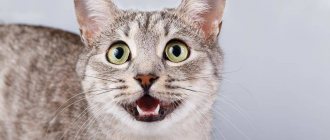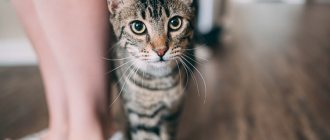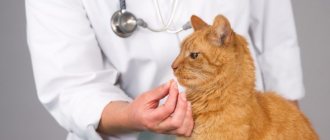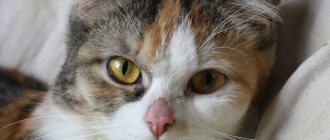What to do if your cat has a miscarriage?
To avoid serious complications, it is important to first find out why the cat had a spontaneous abortion. Therefore, even if the animal feels fine after a miscarriage, it should still be shown to a veterinarian, who, after an initial examination and history taking, will give directions for additional diagnostic tests:
After the incident, it is advisable that the animal be examined using ultrasound.
- blood and urine tests;
- biochemistry;
- tests for hormonal levels;
- tests for the presence of viral infectious pathogens in the body;
- examination of a smear taken from the vagina;
- radiography and ultrasound of internal organs.
In addition, the veterinarian examines the aborted fetuses in detail, so the owner needs to take them to the hospital. When the exact diagnosis becomes known, the doctor will select the optimal treatment regimen that will help eliminate the pathology that caused the spontaneous abortion. Veterinary specialists often advise owners to sterilize their pet after a miscarriage, of course, if it does not actively participate in the reproduction of offspring. This will help avoid complications in the future and prolong the life of your pet.
Return to contents
Possible complications after a miscarriage
If a miscarriage occurs in the early stages, the owners do not notice it. It can also pass without a trace for the pet’s health. Spontaneous abortion after 6 weeks can have serious consequences. The embryos are already large, their rejection can lead to:
- rupture of the uterus, birth canal and perineum;
- tissue necrosis;
- pyometra - accumulation of pus in the uterine cavity;
Pyometra is purulent endometritis, accompanied by accumulation and retention of purulent exudate in the uterine cavity. - sepsis (leads to the death of the pet).
If the fetuses are not expelled from the uterus, but die in utero, this is a very dangerous condition for the cat, as they will begin to decompose, poisoning the pet’s body. The uterus itself becomes inflamed. As a result, intoxication occurs, as a result of which the animal dies. In this case, the cat can only be saved by the attentiveness of the owner, who will notice in time that something is going wrong and contact the veterinarian. The first signs of this condition:
- increased temperature in a cat;
- the appearance of purulent leucorrhoea (discharge from the loop) with a pungent odor.
[custom_ads_shortcode2]
Possible consequences
A frozen pregnancy in a cat is itself a symptom that not everything is in order with the animal’s body. Therefore, if your pet has ever had a miscarriage, the veterinarian will advise castrating her to avoid dangerous complications in the future. If preterm labor begins late in pregnancy, the risk of serious damage to the uterus and birth canal increases. In addition, miscarriage is often accompanied by heavy bleeding, untimely elimination of which can cause the death of the cat.
The longer the dead fruit remains inside the animal, the higher the risk of developing pyometra.
If the fruits decompose inside the womb, an inflammatory-purulent complication in the uterus rapidly begins to develop, leading to pyometra and sepsis. Often a miscarriage leads to the following complications:
- endometritis;
- formation of malignant tumors;
- hormonal imbalance;
- chronic inflammatory processes in the uterus and birth canal;
- decreased protective functions of the body.
Types of miscarriages in cats
Fruit resorption
A miscarriage in a cat in the early stages is most often accompanied by resorption of the fetus. Such a miscarriage does not pose a threat to the animal. In addition, with it there is a possibility that one or more fetuses will not die, but will develop further in the womb.
Death of fruits
With this type of fetal loss, they can die at any stage of pregnancy. Such a miscarriage is more dangerous for the cat, because... accompanied by bleeding and discharge of pus. But in the absence of complications, this miscarriage may not be noticed by the animal’s owners, because she usually eats the fruits.
Death of fruits without their release
This kind of intrauterine miscarriage is the most difficult, as it causes severe inflammation of the genital tract, bleeding and the release of pus/mucus.
Symptoms of miscarriage
Before moving on to answering the question of what to do if a cat miscarries, you should understand several aspects of this problem. In particular, find out what the symptoms of a miscarriage in a cat may be.
© shutterstock
No signs of pregnancy
Miscarriage in a cat is often complicated by the fact that its signs are often almost invisible to the owner of the animal. Sometimes you can find out that a miscarriage has occurred only by noticing the absence of signs of pregnancy in your pet. The fact that the cat does not develop a belly, although it should, and also does not grow in appetite, is often associated precisely with the loss of the fetus.
Bad feeling
After a miscarriage, the cat often doesn't feel well. This can manifest itself both in the form of a strong increase in temperature (above 39 C), and in the form of lethargy, diarrhea, vomiting, long-term lack of appetite, etc.
Soreness, discharge, odor
In addition, a miscarriage may be indicated by such signs as pain in the cat when you feel its abdomen (it dodges, meows, etc.), discharge from the genitals (including bleeding) and/or an unpleasant odor from them same.
Anxiety, nervous condition
You should also start to worry if you notice an unusual state of the cat: increased agitation, a nervous state, anxiety, etc. All this can also be symptoms of a miscarriage.
If you notice at least one of the listed symptoms in your pregnant pet, you should immediately contact your veterinarian.
Consequences of miscarriages
Spontaneous abortion in most cases is stressful for the cat's body. The only exception is that fruits that dissolve in the early stages do not cause any discomfort. The following miscarriage scenarios are most dangerous for a cat’s health:
- miscarriage in late pregnancy.
It is logical to assume that the more developed the fetuses are, the more painful it will be for the animal to experience their exit from the uterus. Such a miscarriage sometimes ends with rupture of the reproductive organ or birth canal. Even if this does not happen, the animal is severely emaciated due to the loss of a large amount of blood; Miscarriage in late pregnancy is the most difficult for cats - miscarriage not accompanied by expulsion of the fetus from the uterus.
Decaying embryos poison the cat’s body and in the future can even lead to necrosis of the uterus if they are not removed from it in a timely manner. Another serious consequence of this type of miscarriage is infection of the pet’s blood. The consequences of a miscarriage are not always visible to the naked eye.
Regardless of the type of miscarriage, veterinarians note the following impact of this unpleasant episode on the cat’s future life:
- the animal has permanent foci of inflammation of the reproductive organs;
- experienced spontaneous abortion most likely leads to infertility of the cat;
- a miscarriage will likely have a negative impact on all subsequent pregnancies, worsening their course and complicating labor.
Sometimes, after a miscarriage, a cat loses the opportunity to become pregnant again.
Factors that provoke miscarriage
The root causes of a frozen pregnancy in a cat can be very diverse, but the most common are:
- Age. Both older and younger cats are at risk. Pets less than a year old often give birth to premature and non-viable kittens. In cats after 5-7 years of age, miscarriages are associated with physiological age-related changes in the body, under the influence of which the animal is not able to fully bear offspring.
- Inbreeding. A common reason why a cat miscarries in the early stages. If mating occurs among closely related pets, the likelihood of developing intrauterine anomalies and premature birth increases many times.
- Poisoning. Profuse vomiting, poor general health, internal bleeding are signs of severe poisoning. In this case, the body tries to get rid of everything that in one way or another interferes with normal recovery, including kittens developing in the stomach.
- Viral infectious diseases. If a cat has chronic fungal, infectious or acute viral diseases, even in the later stages they can cause complications and provoke the death of the offspring.
- Obesity or dystrophy.
- Congenital or acquired pathologies of the structure of the organs of the reproductive system.
- Hormonal imbalances.
Other reasons
Certain drugs, if taken uncontrolled, can lead to this condition in the animal.
The course and favorable outcome of pregnancy are affected not only by internal, but also by external factors. The following exogenous factors can provoke miscarriage in cats early or late:
- uncontrolled use of medications that negatively affect fetal development;
- stress;
- a large number of pregnancies in a short period of time;
- injuries, bruises.
Other complications of pregnancy in cats (dangerous)
1) Uterine bleeding in cats
It is characterized by copious discharge of blood and blood clots from the cat's vulva.
Causes of uterine bleeding in cats: trauma, exposure to pathogenic microorganisms on the placenta.
As a rule, uterine bleeding provokes or is a sign of miscarriage in cats; but with timely veterinary intervention, a cat’s pregnancy can be saved.
2) Torsion of the uterus in a cat
There is a twisting, twisting, bending, bending of one of the “horns” of the uterus (the cat’s uterus is bicornuate, i.e. has the shape of the letter Y).
Causes of uterine torsion in cats: trauma.
Leads to intrauterine death of the fetus(es) without miscarriage and removal of the uterus; with timely veterinary intervention, and if torsion occurs late in pregnancy, kittens can be removed by caesarean section.
3) Ectopic pregnancy of a cat
An ectopic pregnancy in a cat is primary - the fetuses immediately begin to develop outside the uterus; and secondary - the fetuses develop outside the uterus due to its rupture.
Causes of ectopic pregnancy in cats: unknown (primary ectopic pregnancy); trauma, pathology of the uterus/oviducts, etc. (primarily thinning of their walls, leading to ruptures, with secondary ectopic).
In all cases, it leads to the death of the fetus and its surgical removal; in the absence of timely surgical intervention, sepsis and necrosis develop, which can lead to the removal of some of the cat’s internal organs or to its death. Happens extremely rarely.
4) Post-term pregnancy with a cat
It is characterized by the absence of labor in a cat after the 70th day of pregnancy.
Reasons for post-term pregnancy with a cat: intrauterine fetal death, large fetal size, large number of fetuses, hormonal imbalance; pathology of the cat’s reproductive tract (narrow pelvis, etc.)
Post-term pregnancy with a cat usually results in a cesarean section with removal of the fetus (live or dead).
If timely surgical intervention does not affect the cat’s health in any way; if untimely - sepsis, necrosis, death of the cat.
Complications leading to miscarriage
Pregnant cats sometimes experience various complications, which, although not always leading to miscarriage, do increase the risk of miscarriage.
© shutterstock
Damage to the uterus
The uterus in cats has two peculiar “horns” (it is somewhat reminiscent of the English Y), and damage to at least one of them (twisting, fracture, mainly caused by injuries, for example, when meeting a dog) results in a miscarriage in the cat. Kittens with such injuries can be saved only in late stages of pregnancy, using a caesarean section.
Internal bleeding
A large amount of blood released from the cat’s uterus also often leads to the loss of offspring or directly accompanies a miscarriage. However, pregnancy can be saved if you consult a veterinarian in time.
Ectopic pregnancy
This is the rarest, but most dangerous cause of miscarriage in cats. Ectopic pregnancy can be primary (fetuses develop outside the uterus from the very beginning) or secondary (due to damage/rupture of the uterus). In one hundred percent of cases it leads to the death of the offspring, and in the presence of complications, to the death of the mother.
Preventing miscarriage
Miscarriage in a cat is rare. For the most part, pregnancy proceeds without any particular complications, and the cat also copes with childbirth on its own. But this situation can and should be avoided:
- If a cat’s pregnancy is planned (this applies to breeding sires), then before conception the cat should be examined by a veterinarian for possible diseases and preventive measures.
- If the pet is of “noble” origin, this does not negate the fact that it has all the required vaccinations and anti-parasitic treatment procedures. If a person has taken responsibility for an animal, then it should be fulfilled in full.
- You should not suddenly change your diet once you become pregnant. The cat should eat its usual food.
- It is necessary to take a course of vitamins during pregnancy, which will be recommended by the veterinarian.
Observation by a veterinarian
As mentioned above, consultation with a specialist is necessary before planned conception. But even during pregnancy you should not neglect visiting a doctor:
- the veterinarian will give the necessary recommendations, prescribe a course of vitamins, and examine the cat by taking samples;
- after the 4th week, you can do an ultrasound to make sure that the kittens are alive and positioned correctly, the uterus is in good condition;
- Closer to childbirth, it is better to invite a doctor for an examination at home, so as not to irritate your pet with the trip, he will make sure that she is feeling normal and there are no signs of premature birth.
Nutrition
A cat's diet during pregnancy should be balanced. She should receive enough vitamins. This is not difficult to do if the cat eats dry food. Many manufacturers have lines of food specifically for expectant mothers.
High-quality dry food intended for pregnant and lactating cats will provide their body with all the necessary elements
If the cat eats natural products, then taurine should be included in the diet. This element prevents premature termination of pregnancy and reduces the risk of abnormalities in the fetus. It is impossible to overdose; excess is simply eliminated by the body. It is contained in:
- red meats and fish;
- chicken heart and liver;
- turkey meat (champion in taurine content).
The need for rest
During pregnancy, the cat needs to be given the maximum opportunity to rest peacefully. The animal's activity decreases. It is very important to explain to children that rough play with a pet is unacceptable. You should not pick up the cat unless necessary, so as not to put pressure on the stomach.
What to do if a cat gives birth to a dead kitten
The first thing to do if a cat gives birth to a visually dead kitten is to try to bring it back to life. First of all, the baby needs to be freed from the membranes. Then clamp the umbilical cord, trim it with sterile scissors, and treat the wound with an antiseptic solution.
There may be mucus in the baby's mouth and nose. In this case, you need to clear the airways using a small syringe. After this, the kitten is wrapped in a clean cotton towel, lowered upside down and the respiratory system is completely cleaned.
When resuscitating weakened kittens, mouth-to-mouth artificial respiration can be used. This is done using a straw or syringe. Air is blown in taking into account the size of the animal’s lungs - in small portions at intervals of three to five seconds.
For your information. If there is no heartbeat, you can resuscitate a kitten in no more than five to seven minutes, but if the heart can be heard, no more than a third of an hour.
If resuscitation does not bring results, the kitten can be considered dead. It should be wrapped in a plastic bag and then taken to a veterinarian to determine the cause of death.
After the cat has recovered from giving birth, she and the cat who is the father of the stillborn kitten must be shown to a veterinarian. The examination will rule out the presence of inflammatory processes in the uterus, incompatibility of blood groups, and infections.
Be sure to read:
Can a cat give birth to one kitten if the fetus is in the birth canal, what to do?
The effect of infections on miscarriage
Both viral and bacterial infections can cause miscarriage. The most dangerous infections that threaten the successful course of pregnancy in a cat are given in the table below.
Table 1. Infections that threaten cat pregnancy
| Name | Symptoms |
| Calcivirosis | 1. The animal's mouth, nose and tongue become covered with ulcers, resulting in profuse salivation, leading to sticking of the fur around the mouth. 2. The cat sneezes often. 3. There is frequent discharge from the eyes and/or nose. 4. The general condition of the animal can be described as depressed: the cat moves little, has no interest in food |
| Rhinotracheitis (herpes) | Most of the symptoms of rhinotracheitis are similar to the symptoms of calcivirosis, so it is very difficult to make a correct diagnosis at home. Cats infected with this disease begin to sneeze, they develop discharge from the nose and eyes, their body temperature rises, and they refuse to eat. The only difference: with rhinotracheitis, the ulcer spreads mainly to the eyes |
| Panleukopenia (distemper) | 1. The incubation period is characterized by a general deterioration in health, lethargy and refusal to eat, as well as bouts of vomiting interspersed with blood and mucus. 2. The cat’s temperature begins to rise, which can rise to 42 °C. 3. Diarrhea is added to vomiting; its consistency is similar to water and leads to even greater dehydration of the body. 4. As the disease develops, cats' gums turn blue and their larynx swells. It should be borne in mind that the death of an animal can occur suddenly, even in the absence of an incubation period, if we are talking about a hyperacute course of the disease |
| Leukemia | 1. The cat's lymph nodes are enlarged. 2. The cat is losing weight due to loss of appetite. 3. The animal's fur becomes significantly worse in quality than before. 4. The cat develops inflammation localized in the oral cavity (stomatitis). 5. Body temperature rises. 6. Attacks of diarrhea are possible. Please note that different cats with leukemia exhibit different groups of symptoms. |
| Escherichia coli | 1. Lack of appetite in the animal is accompanied by noticeable emaciation. 2. The cat shows aggressive resistance when the owner or veterinarian tries to feel its stomach. 3. The cat is constantly or occasionally feverish. 4. The animal often vomits for no apparent reason. 5. The cat has bouts of diarrhea. 6. Against the background of E. coli, the pet may also develop rhinitis or some signs of conjunctivitis. 7. Dehydration due to vomiting and diarrhea |
| Hemobartonellosis | The main feature of this disease is that it is difficult to recognize. It may not manifest itself in the animal’s body for more than one year, poisoning its life and not giving any warning signs to the owner. Among the nonspecific symptoms that may indirectly indicate hemobartonellosis are the following: 1. The cat has a constantly elevated temperature. 2. There is a rapid heartbeat and rapid breathing. 3. The pet begins to experience an unhealthy interest in inedible objects - sand, plastic, food waste. 4. The mucous membranes turn pale or turn yellowish. 5. The animal gets tired faster than usual and spends a lot of time lying down. Miscarriage in a female with hemobartonellosis occurs due to maternal anemia, which contributes to the death of embryos |
How to prevent your cat from getting infected?
Despite the fact that the infections listed above have varying degrees of impact on the body, they are almost equally dangerous for a pregnant cat. You can protect your animal from this group of diseases using the following methods:
- careful adherence to hygiene standards when keeping a cat;
- a ban on independent walking (this way you can prevent the female from meeting potentially infectious stray animals);
- timely vaccination;
- creating a healthy diet;
- preventive examinations at the veterinarian and passing all prescribed tests (especially during pregnancy).
Vaccination given before mating will help prevent infection of a pregnant female.
If you monitor your pet's health and look for alarming changes in behavior, you will be able to maintain normal health and promote the survival of the fetuses. Many infectious diseases, if we are talking about an already infected female, can be successfully cured in the early stages without consequences for the animal.
Why do cats miscarry?
Veterinarians state that the most common causes of pathology are infections and injuries. The last one is clear. A pregnant cat should be protected from excessive activity and should not be allowed to climb to heights. Unnecessarily, there is no need to pick up the expectant mother and carry out traumatic manipulations with her.
As for infections, it is more difficult in this regard. The owner cannot protect his ward from infection. Sometimes she may visually look happy and active, but at the same time be a carrier of infection. If your pet constantly has self-abortions, then she definitely needs to be examined. By ignoring this, the owner exposes his ward to great danger. There is no need to think that self-healing from hidden infections can occur. Every cat pregnancy will end in miscarriage, because an infection that has penetrated the placenta will not allow the embryos to develop normally.
Possible causes of self-abortion may be early or late mating, that is, before one year and after eight years of age. Poisoning, chronic diseases, helminthiases, pathologies of the feline reproductive system, drug therapy, stress, and hormonal disorders can also cause pathology. Sometimes the cause is easily eliminated. In other cases, the veterinarian may recommend a course of therapy or sterilization.
If a pet has a self-abortion, it is recommended to donate the embryos for research. The cat must be fully examined: ultrasound, x-ray, blood biochemistry.











